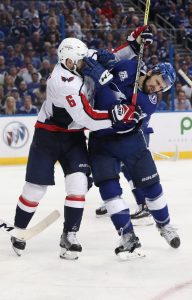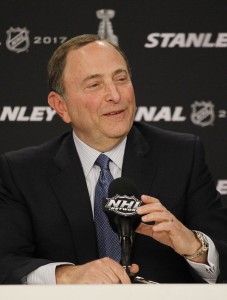Boston Bruins GM Don Sweeney spoke with the media today from the NHL Draft Combine in Buffalo and was very up front about the team’s plans this off-season. The Bruins exceeded expectations this season with a young team that finished with one of the best records in the NHL. Sweeney has previously stated that he would like to return many of the team’s impending unrestricted free agents – Anton Khudobin, Riley Nash, Rick Nash, Tommy Wingels, Tim Schaller, Nick Holden, and Austin Czarnik – but due to salary cap restraints and a promising prospect crop in the AHL in need of opportunity, he did not expect that all would be back. Today, Sweeney went in a different direction, confirming that the team would not offer new contracts to several other free agents: Brian Gionta, Kenny Agostino, and Paul Postma. The announcement should come as no surprise, as the trio all underwhelmed in Boston this season. A late addition to the team for the stretch run and postseason, Gionta looked as if he would have been better off retiring after the Olympics. The veteran forward contributed only seven points in 20 regular season games and played in just one playoff game, in which he was a liability against the fast-paced Tampa Bay Lightning. Gionta is likely to call it quits for good this off-season. Agostino, the 2017 AHL MVP, not only made little difference in Boston with just one point in five games, but finished the minor league season in Providence with 30 points less than his MVP campaign in only one less game. Agostino will need to search for a new home for the third straight summer. Postma, while not necessarily a disappointment in Boston, ended up being of little use to the team. The relative health of the Bruins’ four right-handed defenseman and the emergence of rookie Matt Grzelcyk on the left side made Postma the #8 option for much of the year. He was unable to even retain that role after the Bruins acquired Holden at the trade deadline. Overall, Postma played in 14 games in Boston, recording just one point, before clearing waivers and being assigned to the AHL, where he played another 17 games with Providence in the regular season and postseason. The long-time Winnipeg Jets defender will be on the hunt for a more regular NHL role next year, if he can find one.
- Sweeney briefly touched on the situation with Czarnik, which has put the Bruins in somewhat of a pickle. Czarnik, 25, played in 49 games as a rookie with Boston in 2016-17, but lost out on a roster spot this year to the likes of fellow youngsters Jake DeBrusk, Danton Heinen, Anders Bjork, and Sean Kuraly. Czarnik managed to play in ten games for the Bruins, and looked good doing so with four points, but roster restrictions forced him back to the AHL each time. In the minors, Czarnik was unstoppable with 69 points in 64 games – good enough for third in the AHL scoring race. It was an impressive performance, but still not good enough to vault Czarnik back to the top of a Bruins’ prospect pipeline that is very deep, especially at center. Ideally, the Bruins would have liked to deal Czarnik as a restricted free agent with his value at its highest. However, as a 25-year-old with three pro seasons under his belt but less than 80 NHL games played, Czarnik instead qualifies for Group 6 unrestricted free agency per the NHL CBA and is free to sign with any team. Sweeney expressed that both the team and Czarnik have not closed the door on an extension, but that he feels Czarnik is “intrigued by what may exist elsewhere”. There will surely be a market for the swift, play-making forward and a return to Boston seems unlikely.
- Sweeney also updated the injury status of his team, revealing that banged-up checkers Schaller and Noel Acciari both underwent surgery following the season. The Bruins’ fourth line, while not much of an offensive threat, was one of the best defensively this season. However, their play began to tail off in the postseason and the major injuries for Schaller and Acciari certainly lend some explanation to that trend. The duo were just two of myriad injuries for Boston, but join only Brandon Carlo in going under the knife. Sweeney stated that the rest of the injured – Torey Krug, Zdeno Chara, Patrice Bergeron, Brad Marchand, David Backes, DeBrusk, Nash, and Nash – will all avoid surgery for now.
- Finally, Sweeney responded to a question about whether or not he would try to trade back into the first round of the NHL Draft next month. The Bruins sent their first-rounder to the New York Rangers in the Rick Nash deal and do not own any other team’s pick. Sweeney seemed hesitant to promise anything, saying that it is “hard” to trade back in, but did add that “you never know what some team may want to do”. In a draft class that many feels runs out of elite prospects after the first 15 or so selections, Boston may not be scrambling to trade current or future assets for a first-round pick anyway. With a late second and an early third from the Florida Panthers, the Bruins should be able to add two players with similar career projections to some late first-round picks. Even if they don’t get a future star, the Boston system is one of the best in the league with more than enough talent pushing for play time in the NHL as it is.

